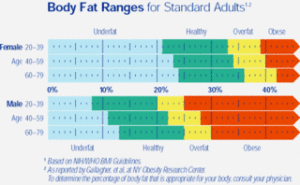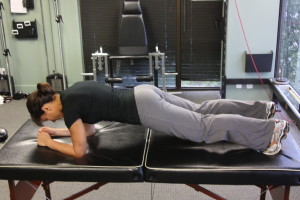- You are here:
- Home »
- Blog »
- Fitness After 40 »
- Three Exercises You Would Never Think Of For A Flatter Belly
Three Exercises You Would Never Think Of For A Flatter Belly
Each year, millions of Americans all get excited about the same time and about the same thing: working out to re-shape their bodies; to look better; to have a flatter belly. So, they join a gym and hit the cardio and weight machines. Most of them quit within three months and take their less than flat bellies home.
If you want a flatter belly, you have to do at least two things:
- Reduce subcutaneous fat
- Increase muscle tone
Lose the Fat
Subcutaneous fat is fat under your skin. It’s what covers your abdominal muscles. You can do hundreds of crunches a day and never flatten your belly because crunches won’t help you much in shedding body fat.
To get rid of the fat, you’ll need to examine your diet and perform exercise routines that increase your energy expenditure.
Each pound of fat contains 3500 calories of energy. So, you either have to reduce your intake of calories by 3500 to lose a pound of fat (and not all in one day!) or increase your expenditure of calories through exercise or both.
Sort of.
A calorie is not a calorie. A calorie of sugar is processed differently in your body than a calorie of broccoli.
Steps to take:
- Eliminate sugar. I don’t mean fruit but rather any refined sugar. Anything that comes in a box, package, or container. Basically any type of processed food that contains sugar as well as candy, ice cream , sodas.
- Get rid of refined carbohydrates. Examples include pastas, breads, crackers, chips, pretzels. Snack foods have to go.
- Make sure you eat enough protein. Most people don’t and it’s very important for recovery from training, injuries and for regulating blood sugar.
- Eat enough “good” fat. Okay, so this one makes just about everyone nervous. Fat? You’re kidding right? No, I’m not. The low fat diet promoted by the U.S. government in the 90′s has failed. We’re a fatter, sicker nation than ever. Good sources of fat include butter made from organic cream, foods rich in omega-3 fatty acids, which studies show can help lower the risk of arthritis, heart disease, and some cancers. Complement your omega-3 intake with monounsaturated fats from extra-virgin olive oil, and avocados.
- Stay hydrated. The old rule of “64 ounces per day” was based on an “average” person of 150lbs. If you weigh more than that, shoot for ~ 50% of your body weight in ounces per day.
- Limit alcohol. Leanness and alcohol are sworn enemies. It’s very tough to shed the excess fat if you drink a lot.
In theory, if you reduce your caloric intake by 200 calories per day (that’s 1½ Cokes or, 1 glass of wine) and increase your expenditure of calories by 300 (jog / walk 30 minutes or lift weights for 30 minutes), you’ll have an overall positive fat burn of 500 calories. If you do this everyday for one month (30 days), you’ll have burned 15,000 calories and lost just over 4 lbs. of fat.
I say, “in theory”, because what happens in your body with the foods you eat is not as simple as calories in minus calories out. Yes, that’s part of the equation but not the whole thing. More on that in future posts.
The amount of fat you can safely lose depends on how much fat you’re carrying. You can test your body fat levels several ways but the easiest is to use a scale that incorporates body fat measurement or calipers. These tools are fairly accurate (the gold standard is underwater weighing). Once you know your body fat level in percent, compare it to the chart (on the right) to find your ideal amount. Less is not always better. You need a certain amount of fat so avoid chasing the very bottom end of the fat scale.
underwater weighing). Once you know your body fat level in percent, compare it to the chart (on the right) to find your ideal amount. Less is not always better. You need a certain amount of fat so avoid chasing the very bottom end of the fat scale.
“Toning” Your Belly
Once you’ve lost some fat, you’ll need to “tone” or increase the resting tension level of the stomach muscles. A lot of people think that sit-ups or crunches are the best way to do this but not only are sit-ups not all that great for toning muscle, they can injure your spine.
What makes a muscle “toned”? Well, exercises that force the muscle to work hard. All types of strength training exercises can improve your muscle tone but there is one type of exercise that is a little better than others: isometrics.
An isometric exercise is a type of exercise that makes your muscles work but does not produce any movement. For example, when you carry a heavy object, in order to not drop the load, your arm muscles use an isometric contraction. When you mop the floor, your trunk muscles use isometric contractions to hold your body at a particular angle. Isometrics are used often in everyday life and an isometric exercise will recruit about 5% more muscle fiber than other types of exercise.
To use isometrics for your abdominal muscles, try these drills:
One Hand Dumb Bell Swings
- Use a dumb bell, and squat down with the dumb bell between your legs.
- Now, as you stand up, swing the dumb bell up and over your head. Tighten your abdominal muscles especially at the the top of the swing.
- Allow the weight to drop back down to the starting position as you squat back down.
- Repeat 10-15 times; 3 sets.
- This drill is used often in yoga. It looks like a push up but instead of being on your hands and feet, you’re on your forearms and feet (see image). An easier version is the push up position (it’s easier because you get to take full advantage of the latissimus dorsi muscle in that position where you don’t in the forearm position).
- Hold the position as long as you can. Your goal is two minutes.
Squats
- Hard to believe but a squat with enough load will work your the midsection of your body as well as a lot of other parts. When you squat, your abdominal muscles contract isometrically to hold your spine in place. In fact if I had only one drill to choose to build a toned midsection, squats would probably be it.
- The load should be either in front (held under your chin) or on your back. You need to use enough that you struggle through 10-12 repetitions but could do 15. Do three sets.
If you do these drills every other day, you may be sore in the stomach region (but not for long) and you’ll notice that your belly feels tighter within a few weeks. When the drills feel easier (hard to imagine, I know), you can add more repetitions or add a small amount of weight.
To get a flatter belly, burn more fat and tone the abdominals using isometrics.

